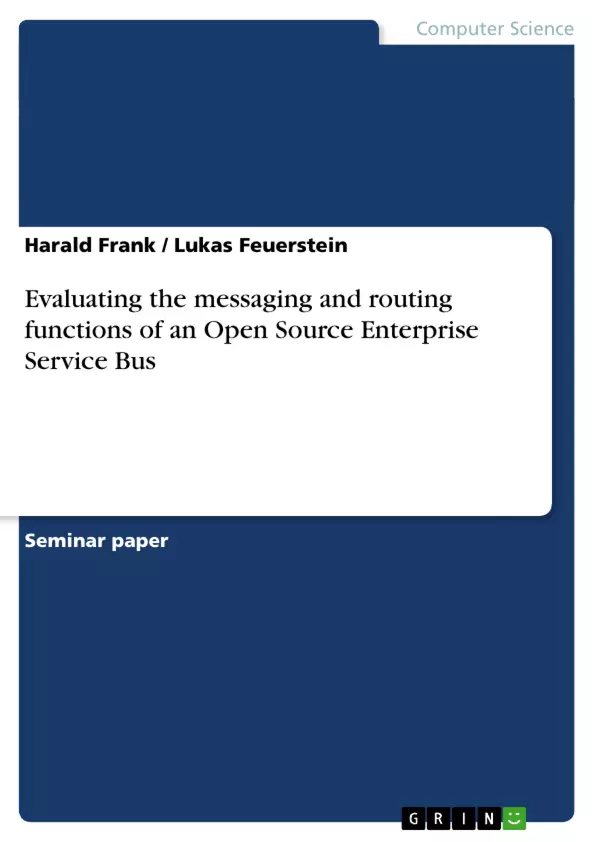Enterprise Service Busses and related concepts like Service Oriented Architectures are increasing in popularity. Businesses are facing new challenges and networking, inter- and intra enterprise cooperation and collaboration are getting more and more crucial for being ahead of the competitors.
Enterprise Service Buses are providing a necessary, high- scalable and flexible IT architecture for integration, an improved communication, and reducing complexity at least in theory.
The major goal of this project seminar is to examine the practical use of ESB. The first part of this documentation will provide the reader with some theoretical foundations on the Enterprise Service Bus, integration paradigms and some required functions of Enterprise Service Buses.
The following section will then focus on one specific Open Source ESB – the Apache ServiceMix that will be presented briefly. Its main functions and concepts will be examined in detail. Furthermore the setup of a generic development environment, debugging principles and tools will be described.
The following part is the development of an explorative case study that illustrates important features and characteristics of an ESB in a practical way. The focus is to illustrate the routing and messaging capabilities of Apache ServiceMix. Based on an everyday example, the message flow in a restaurant, we are trying to demonstrate development principles, analyze useful patterns and also illustrate common pitfalls and challenges.
In the final part, lessons learned and some generic recommendations for possible applications of ESBs are presented. The project team is observing that ESB is a highly important integration model especially in Service Oriented Architectures. Furthermore for some single and clearly defined scenarios the functions provided by Open Source ESBs are already satisfactory. On the other hand side, ESBs are still emergent, there are a lot of instability, complexity and a lack of development tools. The recommendation is to clearly evaluate ESB and also optional other solutions before its practical application in a real world scenario.
Inhaltsverzeichnis (Table of Contents)
- Introduction
- Foundations of Enterprise Service Buses
- Enterprise Integration
- EAI vs. ESB
- Simple ESB example
- Functional requirements for an Enterprise Service Bus (ESB)
- Message Exchange / Routing Facilities
- Message Transformation
- Protocol Transformation
- Security
- Quality of Service
- Management and Monitoring
- The architecture of an ESB
- Decision for ServiceMix
- Apache ServiceMix
- Components of JBI compliant ESBs
- Functionalities of Apache ServiceMix
- Summary of ServiceMix
- Installation of ServiceMix
- Development Environment
- Deployment Environment
- Debug Environment
- Case Study: Future Restaurant
- Description of the Case Study
- Architecture
- Messages
- Components of the Case
- Documentation of Apache ServiceMix
- Conclusion
- Attachments
- Useful Links
- Web Service development: Bottom-Up Approach
- Literature
Zielsetzung und Themenschwerpunkte (Objectives and Key Themes)
This document explores the concept of Enterprise Service Buses (ESBs) within the context of enterprise integration. It focuses on the functionalities, architecture, and implementation of ESBs, using Apache ServiceMix as a practical example. The document delves into the key features and benefits of ESBs, highlighting their role in improving communication and data exchange between various enterprise systems.- Enterprise Integration using ESBs
- Functional Requirements of ESBs
- Apache ServiceMix as a JBI-compliant ESB
- Case Study: Implementing an ESB in a Restaurant Setting
- Practical Guidance on ESB Development and Deployment
Zusammenfassung der Kapitel (Chapter Summaries)
The introduction provides a general overview of enterprise integration and the need for ESBs. It highlights the challenges of traditional point-to-point integration and introduces ESBs as a solution to these challenges.
Chapter 2 dives into the foundations of ESBs, explaining concepts like Enterprise Application Integration (EAI) and comparing it with ESBs. It also provides a simple example to illustrate the basic principles of ESBs.
Chapter 3 outlines the functional requirements for ESBs, covering aspects like message exchange, transformation, protocol handling, security, quality of service, and management. It provides a framework for understanding the essential functionalities that an ESB should offer.
Chapter 4 focuses on Apache ServiceMix, a popular JBI-compliant ESB. It describes the key components, functionalities, and benefits of ServiceMix. This chapter also includes instructions for installation and setting up a development environment.
Chapter 5 presents a case study that demonstrates the application of an ESB in a real-world scenario. It details the implementation of an ESB within a restaurant system, highlighting how ESBs can improve efficiency and communication in a practical context.
Chapter 6 provides documentation and further resources for using Apache ServiceMix.
Schlüsselwörter (Keywords)
This document focuses on Enterprise Service Buses (ESBs) as a key technology for facilitating enterprise integration. It delves into concepts like JBI, Apache ServiceMix, message routing, transformation, security, and quality of service. The case study of a restaurant system provides a practical example of how ESBs can be implemented in a real-world context.- Quote paper
- Harald Frank (Author), Lukas Feuerstein (Author), 2009, Evaluating the messaging and routing functions of an Open Source Enterprise Service Bus, Munich, GRIN Verlag, https://www.grin.com/document/135070



